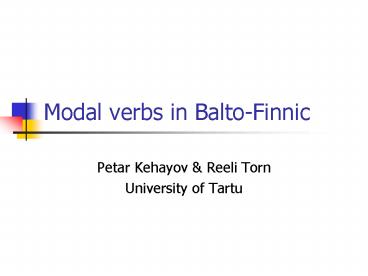Modal verbs in Balto-Finnic - PowerPoint PPT Presentation
Title:
Modal verbs in Balto-Finnic
Description:
Participant-internal possibility (Dynamic possibility, Ability) ... e.g. lack of agentive noun ending in ja *tulla v ija. one who can come' b. ta v ib tulla ... – PowerPoint PPT presentation
Number of Views:46
Avg rating:3.0/5.0
Title: Modal verbs in Balto-Finnic
1
Modal verbs in Balto-Finnic
- Petar Kehayov Reeli Torn
- University of Tartu
2
Key issues
- Types of modality
- The inventory of modal verbs in Balto-Finnic
- Grammaticalization parameters
- Language contact
3
Modality types (van der Auwera Plungian 1998)
4
The inventory of modal verbs in Balto-Finnic
5
The premodal meanings of these core verbs
6
Impersonal vs personal pattern
Mina varim pid läem. (Salats) I
earlier must(hold).PST.1SG go-INF I had
to leave earlier. Minn?n varald pidiks
läem. (Piza) I-DAT early must(hold)-COND.3SG
go-INF I had to leave earlier
7
Grammaticalization parameters (Lehmann 2002)
- Integrity (semantic bleaching, formal erosion)
- Paradigmaticity
- Paradigmatic variability
- Structural scope
- Bondedness
- Syntagmatic variability
8
Integrity semantic bleachingSemantic bleaching
leads to polyfunctionality e.g. saada get
9
Integrity formal erosion
- Morphological degeneration
- lack of person/number inflection
- lack of mood inflection
- lack of voice inflection
- lack of tense inflection
- lack of negative or positive forms
- lack of nominalization(s) that are productive
with other verbs.
10
Loss of person inflectiona shift from personal
to impersonal pattern
Old Written Estonian a. Nende tähtes sannade
sees tullewad meil keige ennamiste
these important word-PL.GEN in come-PRS.3PL we-AD
E SUPER most kaks asja tähhele panna (Seitse
Paasto-Jutlust 1817 56 Penjam 2005 106)
two thing-PRT to_notice-INF In these
important words there are two things that need to
be noticed above all Modern Standard
Estonian b. Nende tähtsate
sõnade sees tuleb meil kõige rohkem
these important.PL word-PL.GEN in come-PRS.3SG we-
ADE SUPER most kahte asja tähele panna.
two-PRT thing-PRT to_notice-INF In these
important words there are two things that need to
be noticed above all.
11
Lack of nominalization(s) that are productive
with other verbse.g. lack of agentive noun
ending in ja
12
ParadigmaticityParadigmaticization shift from
an open class to a closed class of words,
increase in irregularity, fossilization
- Example of fossilization the form of the
potential mood of the Finnish verb lie- has
become a modal particle/adverb
Väliaikana lienee valmistellaan jo seuraavaa
break-ESS be(SPPL)-POT prepare-PRS.PASS already
next-PRT kokousta. (ISK 2004 1522) meeting-PRT
Probably preparations will already be made for
the next meeting during the break.
13
Paradigmatic variability the freedom to chose
between various means for expressing the category
or to leave the category unspecified
- The decrease of such freedom is called
obligatorification by Lehmann. For example, the
Estonian necessity verb tulema to come requires
the subject of the infinitive to be animate (b).
In contrast, the verb pidama to hold, which is
also used for expressing necessity, does not show
such a restriction (a), and, is, thus, more
obligatory
a. Müts peab peas olema. cap
must(hold)-3SG head-INE be-INF A cap must be
worn. (Uuspõld 1989 475) b. Mütsil tuleb
peas olla. cap-ADE
must(come)-3SG head-INE be-INF A cap must be
worn. (Uuspõld 1989 475)
14
Structural scope
- The structural scope of a gram is the structural
size of the construction it helps to form. The
structural scope of the verbs following the
personal pattern see Karelianvoija in (a) is
narrower than the structural scope of those
following the impersonal pattern see Karelian
piteä in (b).
a. Mie voin lähtie makuamah. I can-1SG go-INF sle
ep-INF I can go to sleep. b. Miula
pitäy lähtie makuamah. I-ADE/ALL
must(hold)-3SG go-INF sleep-INF I must go
to sleep. (Pekka Zaikov, p.c.)
15
Bondedness Syntagmatic variability
- Bondedness
- The syntagmatic cohesion or bondedness of a sign
is the intimacy with which it is connected with
another sign to which it bears a syntagmatic
relation. - Syntagmatic variability
- Syntagmatic variability concerns the positional
mutability of a sign with respect to those
constituents with which it forms a construction.
16
Language contact
- Types of language contact
- Lexical borrowing
- Code-copying
17
Language contact code-copying
- Karelian due to the intense contact with Russian
practically all core modal verbs can occur in the
impersonal pattern.
18
Voidgo miu?a teilä üödä moata.
can(be_able)-3SG-Q I-ADE/ALL you-ADE/ALL
night-PRT sleep-INF Can I sleep at your place
tonight. (Palmeos 1962 33). Suawgo
lähtie sinul? (SKJ-LD 1990 364) get(get)-3SG-Q
depart-INF you-ADE/ALL Can you go? Koska auto
rikkautu, meilä piti because car
brake-REFL-PST.3SG we-ADE/ALL
must(hold)-PST.3SG kulkie. walk-INF Because the
car broke down, we had to walk. (Pekka Zaikov
Standard Karelian p.c.)
19
- Hänellä tarviccenut sukeltaa. (Anastassia
Trifonova Olonets p.c.) - s/he-ADE need-PST.PTCP dive-INF
- S/he had to dive.
- miu? tuloo sanuo (Saukkonen 1965 154)
- I-ADE/ALL must(come)-3SG say-INF
- I must say.
- Miu? täydyö lähtie (Saukkonen 1965 147)
- I-ADE/ALL must(get_filled)-3SG depart-INF
- I need to go.
- miula lienöu ruadua. (KKS III 1983 86)
- I-ADE/ALL must(be)-3SG work-INF
- I must work.
20
Verbs used with the impersonal modal pattern
21
West-east cline
22
Conclusions
- Seven core modal verbs in Balto-Finnic.
- Semantically defined class with rather
heterogeneous morphosyntactic properties. - Relatively low degree of grammaticalization.
- The modal system of Balto-Finnic has been
subjected to a considerable external influence.































